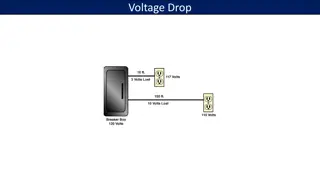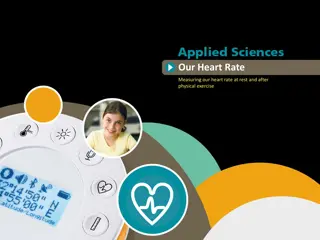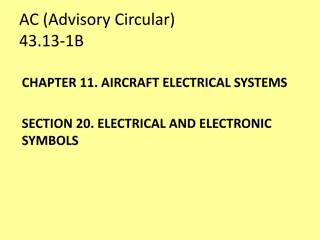Understanding the Electrical Activities of the Heart - An Overview
The electrocardiogram (ECG) is a result of intricate physiological and technological processes involving transmembrane ionic currents, cardiac activation sequences, and electrode connections. The cardiac conduction system consists of various components like the sinoatrial node, atrioventricular node, and His-Purkinje system. Electrode placements for limb leads and precordial leads play a crucial role in recording ECG signals. Explore the complexities and fundamentals of cardiac electrical activities through this informative content.
Download Presentation

Please find below an Image/Link to download the presentation.
The content on the website is provided AS IS for your information and personal use only. It may not be sold, licensed, or shared on other websites without obtaining consent from the author. Download presentation by click this link. If you encounter any issues during the download, it is possible that the publisher has removed the file from their server.
E N D
Presentation Transcript
The ECG is the final outcome of a complex series of physiologic and technologic processes. First, transmembrane ionic currents are generated by ion fluxes across cell membranes and between adjacent cells. These currents are synchronized by cardiac activation and recovery sequences to generate a cardiac electrical field in and around the heart that varies with time during the cardiac cycle. This electrical field passes through numerous other structures, including the lungs, blood, and skeletal muscle, that perturb the cardiac electrical field. The currents reaching the skin are then detected by electrodes placed in specific locations on the extremities and torso that are configured to produce leads. The outputs of these leads are amplified, filtered, and displayed by a variety of devices to produce an electrocardiographic recording.
Cardiac conduction system. The normal conducting system consists of pacemaker cells in the sinoatrial (SA) nodal complex, specialized intra-atrial conducting tracts (including Bachmann's bundle), the atrioventricular (AV) node, the His-Purkinje system, and working atrial and ventricular myocardium.
. , . , . , . : ( I, II III). . I ( ) ( ), II ( ) ( ) III ( ) ( ). .
Electrode connections for recording the standard limb leads I, II, and III. R, L, and F indicate locations of electrodes on the right arm, left arm, and left foot, respectively.
( V1 V6). . V1 , V2 , V3 V2 V4, V4 , V5 V6 . .
Precordial leads A, Positioning of the precordial leads on the chest wall. B, Normal cardiac activation as manifested in the precordial leads. Note the small r wave and deep S wave in lead V1, the transition at around V3 or V4, and the septal q wave and large R wave in lead V6. Electrode locations and electrical connections for recording a precordial lead. Left, The positions of the exploring electrode (V) for the six precordial leads. Right, Connections to form the Wilson central terminal for recording a precordial (V) lead.
aVR = RA - (LA+LL)/2 aVL = LA - (RA+LL)/2 aVF = LL - (RA+LA)/2 Vi = Ei WCT where WCT = (LA+LL+RA)/3
Electrocardiographic leads and reference lines. ECG, electrocardiogram.
Lead Vectors and Heart Vectors. A lead can be represented as a vector referred to as the lead vector. For simple two-electrode leads, such as leads I, II, and III, the lead vectors are directed from the negative electrode toward the positive one. For the augmented limb and precordial leads, the origin of the lead vectors lies at the midpoint of the axis connecting the electrodes that make up the compound electrode. That is, for lead aVL, the vector points from the midpoint of the axis connecting the right arm and left leg electrodes toward the left arm. For each precordial lead, the lead vector points from the center of the triangle formed by the three standard limb leads to the precordial electrode site.
Lead vectors for the three standard limb leads, the three augmented limb leads (left), and the six unipolar precordial leads (right).
. , -30 +90 ( - 30 +120 ) . : , . , .
Hexaxial Reference Frame and Electrical Axis. The lead axes of the six frontal plane leads can be superimposed to produce the hexaxial reference system. The six lead axes divide the frontal plane into 12 segments, each subtending 30 degrees.
The hexaxial reference system constructed from the lead axes of the six frontal plane leads. The lead axes of the six frontal plane leads have been rearranged so that their centers overlay one another. These axes divide the plane into 12 segments, each subtending 30 degrees. Positive ends of each axis are labeled with the name of the lead.
These concepts allow calculation of the mean electrical axis of the heart. The orientation of the mean electrical axis represents the direction of activation in an average cardiac fiber. This direction is determined by the properties of the cardiac conduction system and activation properties of the myocardium. Differences in the relation of cardiac to torso anatomy contribute relatively little to shifts in the axis. The process for computing the mean electrical axis during ventricular activation in the frontal plane is illustrated in next Figure.
Calculation of the mean electrical axis during the QRS complex from the areas under the QRS complex in leads I and III. Magnitudes of the areas of the two leads are plotted as vectors on the appropriate lead axes, and the mean QRS axis is the sum of these two vectors.
: QRS (R-Q-S>0) . -30 ( ) QRS (R-Q-S>0) ( , aVL) QRS (R-Q-S<0) (aVF, ). +90 ( ) QRS (R-Q-S<0) ( , aVL) QRS (R-Q-S>0) (aVF, ).
Chart of frontal plane axes. Normal (NL) = 30 to +100 degrees Left axis deviation (LAD) = 30 to 90 degrees Right axis deviation (RAD) = +100 to +180 degrees Extreme right axis deviation (ERAD) = 90 to 180 degrees Mild RAD is considered normal in children, adolescents, and young adults.
Interpreting the Electrocardiogram The recorded or displayed electrocardiographic tracings are, finally, compared with various diagnostic criteria to identify specific abnormalities.
P. , aVR. <0,1 sec. : 0,1-0,3 mV. PR. P QRS . 0,12-0,20 sec.
Schematic representation of atrial depolarization (diagram) and P wave patterns associated with normal atrial activation (left panel) and with right (middle panel) and left (right panel) atrial abnormalities.
QRS. Q, R S. QRS . QRS: 0,06-0,10 sec. ST. S T. . T. , .
The sequence of ventricular endocardial activation is depicted in Figure. Earliest activity begins in three sites: (1) the anterior paraseptal wall of the left ventricle; (2) the posterior paraseptal wall of the left ventricle; and (3) the center of the left side of the septum. These loci generally correspond to the sites of insertion of the branches of the left bundle branch. Septal activation begins on the left side and spreads across the septum from left to right and from apex to base. Wave fronts sweep from these initial sites of activation in anterior and inferior and then superior directions to activate the anterior and lateral walls of the left ventricle. The posterobasal areas of the left ventricle are the last to be activated.
Schematic representation of ventricular depolarization as two sequential vectors representing septal (left) and left ventricular free wall (right) activation. QRS waveforms generated by each stage of activation in leads V1 and V6 are shown.
Excitation of the right ventricle begins near the insertion point of the right bundle branch, close to the base of the anterior papillary muscle, and spreads to the free wall. The final areas to be activated are the pulmonary conus and the posterobasal areas. Thus, in both ventricles, the overall endocardial excitation pattern begins on septal surfaces and sweeps down toward the apex and around the free walls to the posterior and basal regions in an apex to base direction.
Activation sequence of the normal right and left ventricles. Portions of the left and right ventricles have been removed so that the endocardial surfaces of the ventricles and the interventricular septum can be seen. Isochrone lines connect sites that are activated at equal instants after the earliest evidence of ventricular activation.
QT. QRS T . QT , QT (QTc) = QT/ RR ( Bazett), RR R. QTc 0,35 sec 0,43 sec. U. . . .
Normal Values for Durations of Electrocardiographic Waves and Intervals in Adults WAVE OR INTERVAL DURATION (msec) P wave duration <120 PR interval <200 QRS duration <110-120* QT interval (corrected) 440-450*
Inscription of a normal electrocardiogram (ECG). Sinoatrial nodal depolarization is not visible on the surface ECG; the P wave corresponds to atrial mechanical contraction. The PR interval denotes conduction through the atrial muscle, atrioventricular node, and His-Purkinje system. The QRS complex reflects ventricular muscle depolarization. The ST segment and T wave correspond to ventricular repolarization. Atrial repolarization also occurs, but the signal is of low amplitude and buried underneath the QRS complex. Note the gridlines. On the horizontal axis, each 1-mm line ( small box) denotes 0.04 second (40 msec); a big box denotes 0.2 second (200 msec). On the vertical axis, 1 mm ( small box) corresponds to 0.1 mV; 10 mm (two big boxes) therefore denotes 1 mV.
Normal electrocardiogram recorded from a 48-year-old woman. The vertical lines of the grid represent time, with lines spaced at 40-msec intervals. Horizontal lines represent voltage amplitude, with lines spaced at 0.1-mV intervals. Every fifth line in each direction is typically darkened. The heart rate is approximately 72 beats/min, the PR interval, QRS, and QTc durations measure about 140, 84, and 400 msec, respectively, and the mean QRS axis is approximately +35 degrees.























